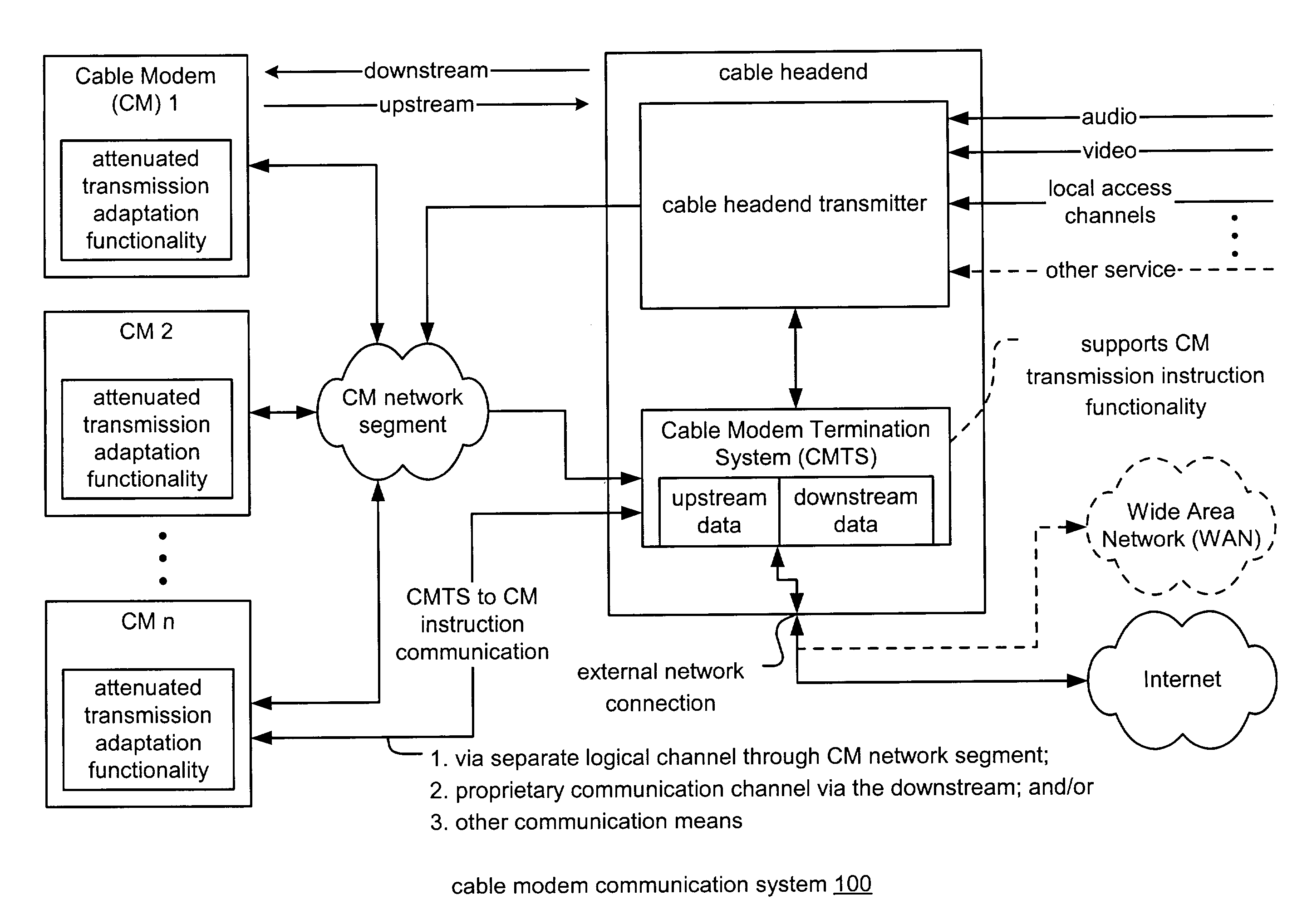The problems presented by attenuation of transmitted signals within communication systems have existed for quite some time.
In many different types of communication systems, there may be an undesirable attenuation of a
signal when being transmitted from a transmitter to a receiver through the infrastructure of the communication
system.
That is to say, a transmitter may experience a large attenuation of its transmitted signals when they travel to the receiver via the communication system.
Thus, the cabling itself from the CM may itself even introduce a large attenuation even before that particular CM cabling, within the
apartment building, is attached to the rest of the cable
plant.
For example, within a
wireless transmission path, where
path length differences between the various devices within the system may vary greatly, with some transmitter-receivers being located relatively close and perhaps within a line-of-
sight of a
wireless termination system, while other transmitter-receivers may be located at a great distance from the
wireless termination system and perhaps have an obscured line-of-
sight and / or destructively interfering multipath.
While there are some prior art approaches to deal with the problems presented by undesirable attenuation of signals as they are transmitted through the communication system, these prior art approaches fail to address this large attenuation within the transmission path without also degrading the efficient operation for the full set of transmitters operating into a given receiver.
For example, in the
cable modem communication system context, these prior art approaches will themselves oftentimes introduce degradation of some, if not all, of the CMs as they transmit signals to the CMTS.
In addition, these prior art approaches will typically significantly increase the complexity of the communication system's components.
This increase in the complexity of the communication system's components, provided by the prior art approaches, is typically found in increases to the complexity of the
Media Access Control (MAC) (sometimes referred to as the Medium
Access Control) and Physical (
PHY) layer components of the communication system.
However, a major drawback of many such Adaptive Modulation approaches is the typically immense complexity associated therewith, especially, but not solely, when resolving the MAC layer issues.
This may be because the receiver is limited to receiving signals using that common set of modulation parameters or characteristics.
As mentioned above, the prior art approach of providing such rapidly changing receiver flexibility at the
PHY layer and at the MAC layer is not without a significant increase in complexity.
Another problem that often arises in such communication systems is an upper limit on the power that a particular transmitter is capable of using, or is permitted to use, to transmit its information.
Such an upper power limit may be imposed by the capabilities of economically implemented transmit amplifiers which are allocated to have a certain maximum transmit power given a spurious fidelity requirement that must be met.
In addition, the regulatory agencies (e.g., the Federal Communications Commission (FCC)) may also impose a limit on transmit power to prevent interference with other services operating within other frequency spectra.
However, because of the inherent limitations of the device, the transmitter can not increase its power beyond an upper limit point, as described above.
Again, this upper
transmitted power limit could be due to standards, wherein the limitations are attempting to allow coexistence with other communications networks or broadcasts, such as
wireless systems.
This power limitation, regardless of which source introduces it, inherently presents a limit by which this prior art approach can employ the increasing of
transmitted power to address this problem.
Yet another problem that arises in such communication system is a problem associated with the multipoint-to-point
connectivity within communication systems.
The attenuated transmission conditions may simply make prior art approaches to perform this
ranging and registering impossible, given the oftentimes relatively low SNR on the communication channel of interest on which the
ranging and registering is to be performed.
However, in an attenuated channel, the ranging burst itself is likely to have a significantly reduced SNR upon arrival at the receiver.
This will again make the ranging and registering of the transmitter challenging.
Even if the ranging and registering of the transmitter may be performed, it is likely to be made with
significant error given the significantly reduced SNR of the ranging burst upon arrival at the receiver.
As such, no prior art solution is able to address the even more complicated situation that arises within multipoint-to-point communication systems having numerous reflections, additional paths, etc. contained throughout the communication system.
In addition, the prior art does not presently provide a solution by which a transmitter can overcome a severe attenuation in its path to the receiver and still maintain a desired SNR at the receiver.
The prior art also presents no solution by which a transmitter can increase the SNR at the receiver without increasing its transmitted
signal power beyond the certain / predetermined limit as described above.
 Login to View More
Login to View More  Login to View More
Login to View More 


